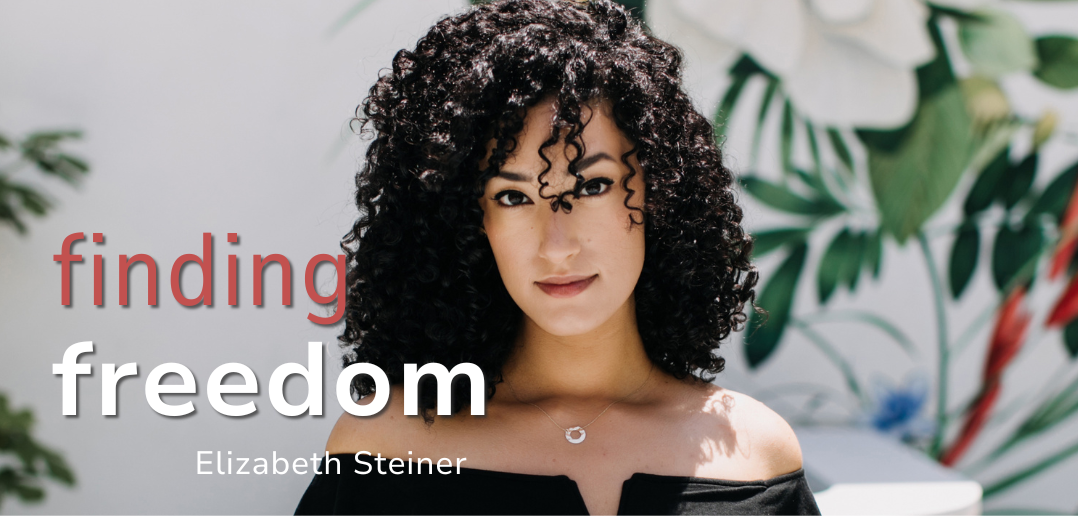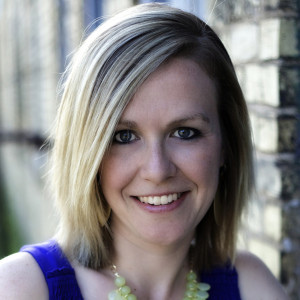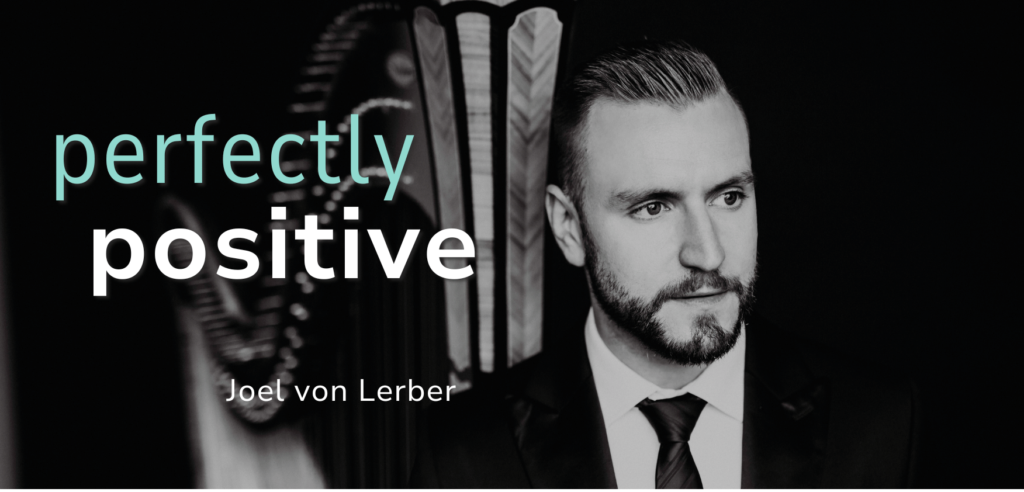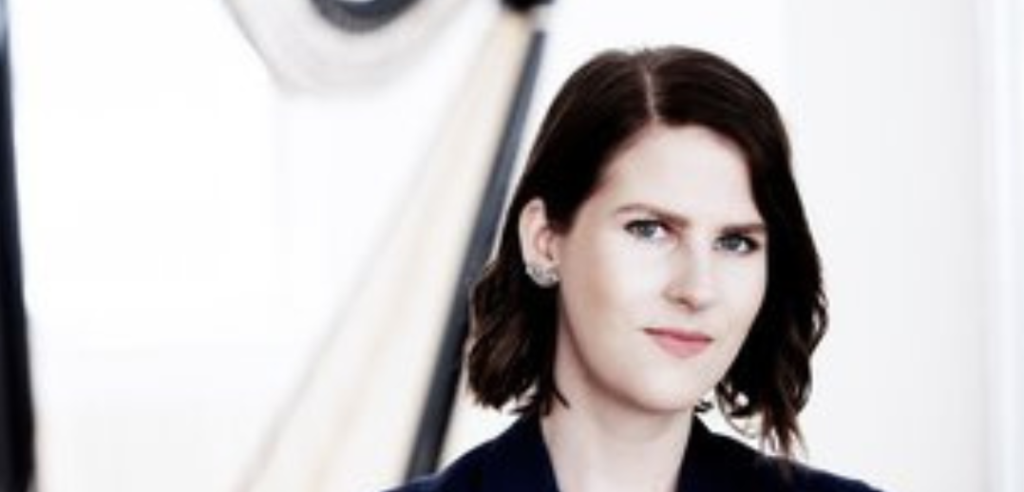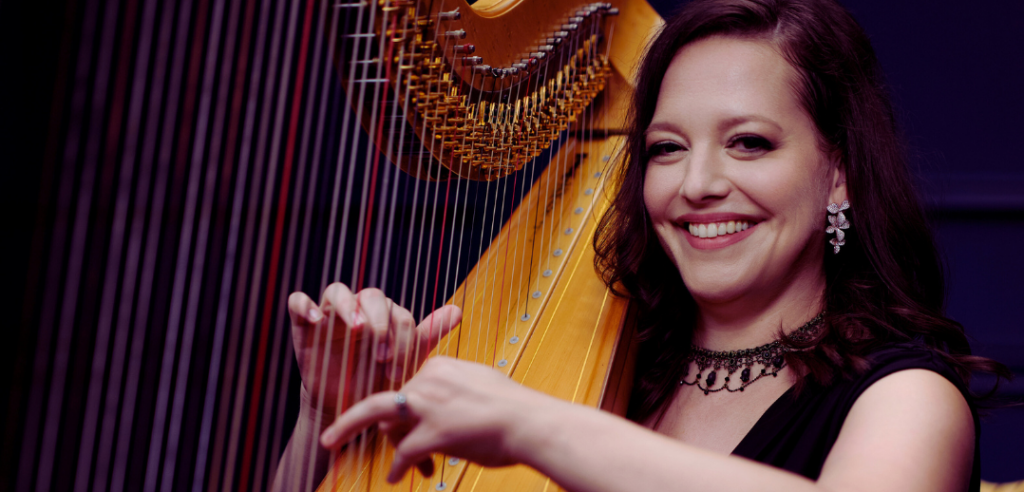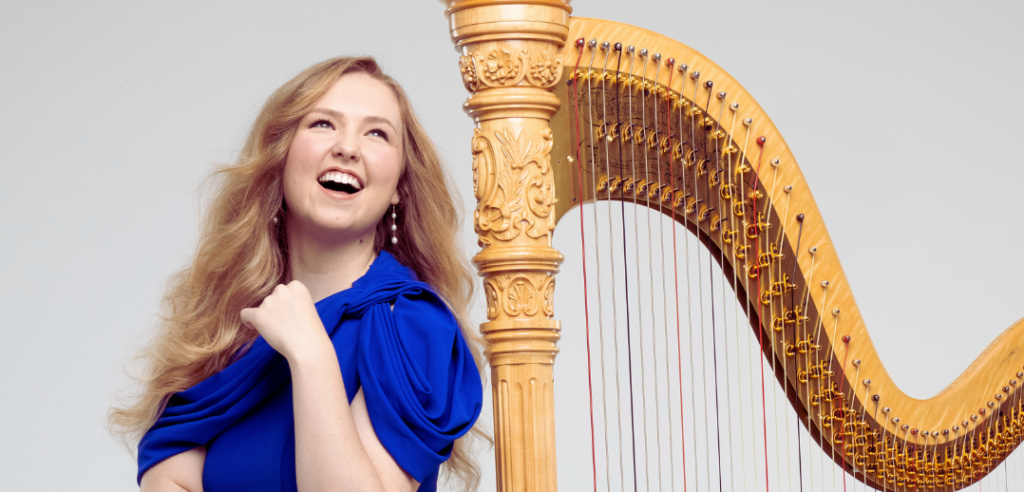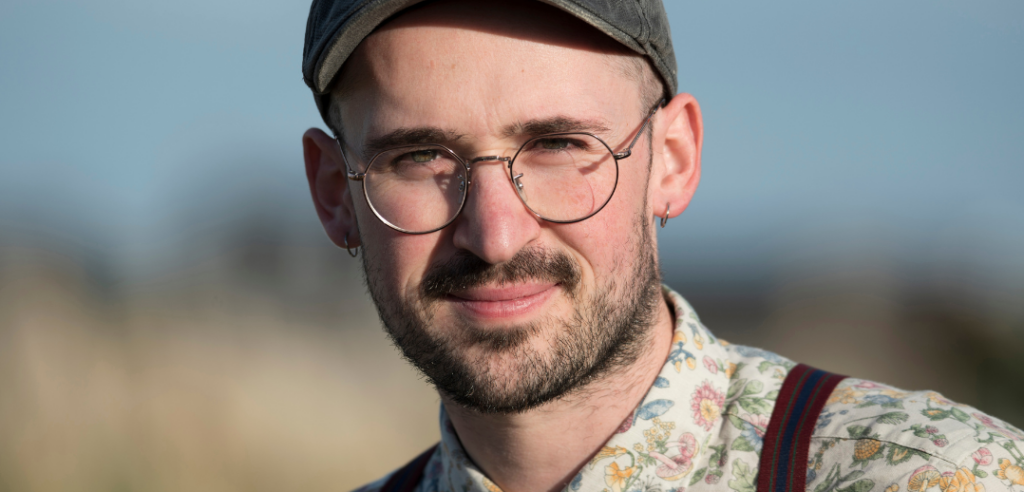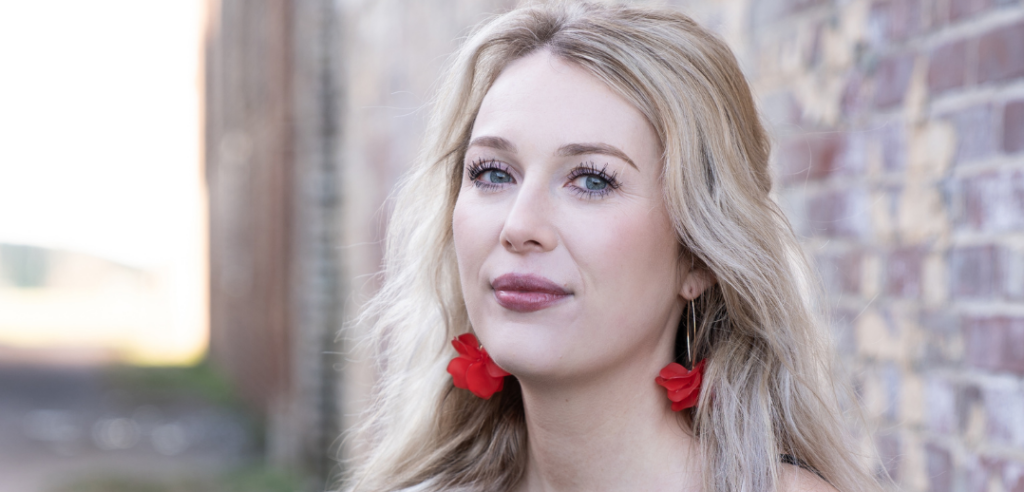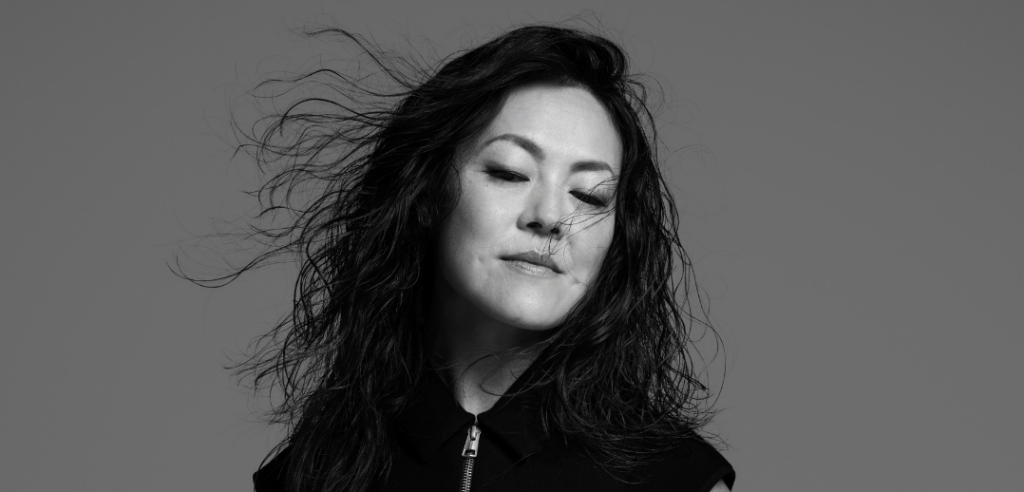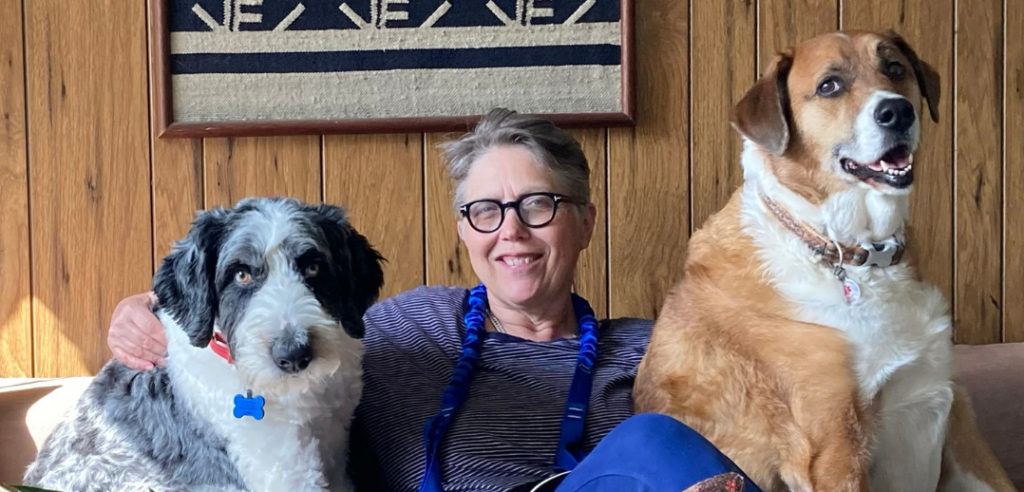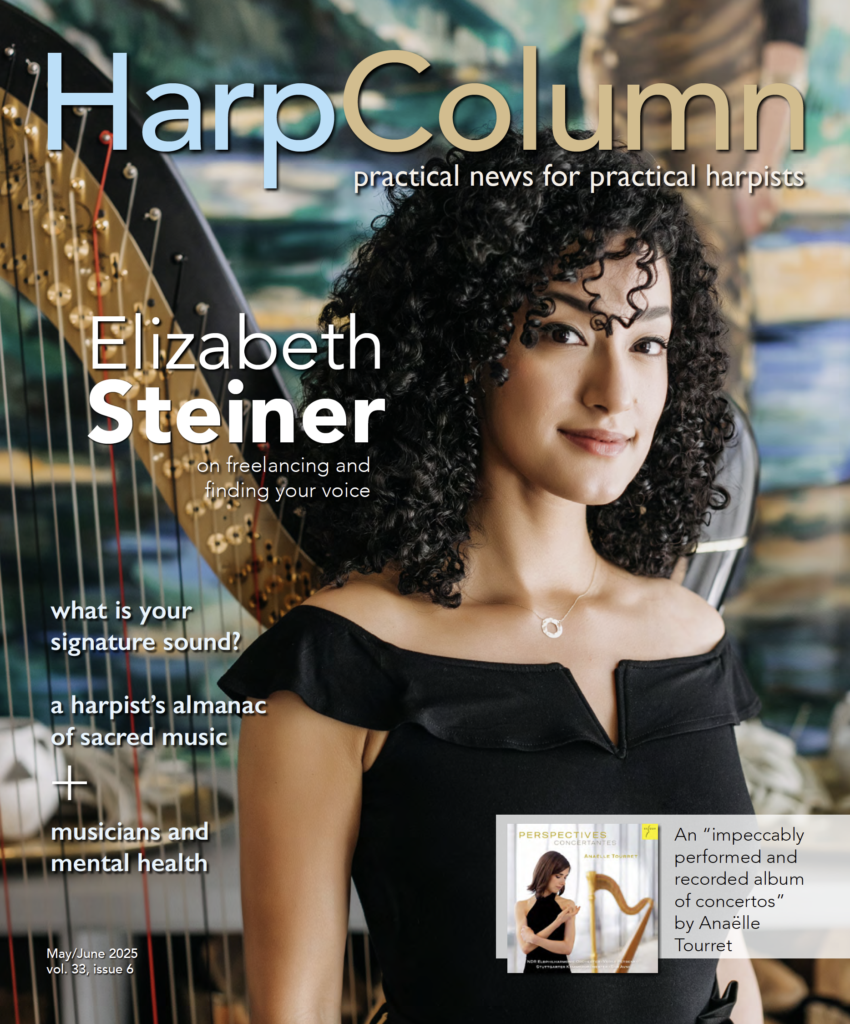I feel like I’m finally at the point where I can say I’m the freest I’ve ever been…I feel like I’ve done the fighting, and now I’m able to lean back and enjoy working on my own sound.
When you think about it, “freelancer” is an odd term. The first half of the word implies a level of blissful independence, while the last half conjures imagery of a medieval soldier wielding a weapon. Yet this is the title many harpists take on as they forge their careers in music. As we profile the third freelancer in our year-long series on this particular breed of harpist, we sit down with Elizabeth “Lizzie” Steiner.
Well into her second decade of freelancing in Philadelphia, Steiner is hitting her stride. Her calendar is the envy of any aspiring independent musician—a steady gig, teaching, recording, arranging, orchestra work, bookkeeping—no two weeks look the same. Steiner wouldn’t have it any other way. After surviving the freelancer apocalypse that was the pandemic, Steiner says she has found her musical and creative voice through arranging, recording, and collaborating with other musicians across genres. And she has never felt more free.
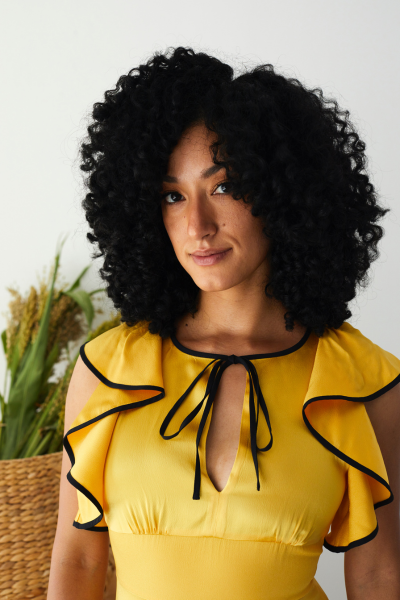
…those times have really shown me who I am and what I’m made of. They’ve affirmed for me that I’m in this for the long haul. I love doing this. If I didn’t, I would’ve quit a long time ago…
HC: This year we’re talking to a lot of freelancers and featuring different types of independent careers. How free do you feel in your career?
ES: Oh, I feel super free, honestly. I feel like I’m finally at a point where I can say I’m the freest I’ve ever been. I was thinking about that term today too—freelancer—because it is kind of like a swordsman or a fighter. You have to go out and fight for what you want to be doing. I feel like I’ve done the fighting, and now I’m able to lean back and enjoy working on my own sound. The more I cultivate that, the more opportunities I have that feel almost eerily aligned with me right now. Random recording projects have been coming up—people I’ve listened to, but never interacted with, reaching out. These synchronistic things are starting to happen, and I’m really grateful for that. I feel like I’ve done just about everything you can do in the harp world—and I still do all of it and enjoy it—but now, in this modern landscape, there’s so much more space to be a specialist. You can be more intentional about pairing up with musicians, sounds, groups, and projects that are really interesting to you. That said, I also have to acknowledge that I have steady work—like playing regularly at a hotel, teaching, and doing all the other things we freelancers do. That steady foundation is what allows the freedom. Without that consistent base—like private events and other regular gigs—I wouldn’t have the financial stability that gives me the room to be more experimental and explore creative opportunities. So I’m really grateful for that balance.
HC: A couple of years ago, you wrote a Sounding Board article for us about your experience playing a tribute concert to Notorious B.I.G. at Lincoln Center. One of the things you wrote really stood out. You said, “Moments where your knowledge, skills, and passions intersect with the music you’re being asked to play—moments where you get to perform with other incredible artists to deliver something you all love and something the audience can deeply appreciate. Moments like this create such a satisfying experience for all involved.” I think you really hit on that core reason why a lot of musicians do what they do. Can you point to anything specific in your background that prepared you to have that kind of moment of discovery?
ES: Honestly, it goes all the way back to childhood—listening to [Notorious B.I.G.] records at my parents’ house, or downloading them on Limewire in the middle of the night. But during the tribute concert, there were these really fast, opening scales written as glissandos, and I decided to just play them as straight scales instead. It made them pop more—sparkled more in the texture. And I realized, I’m so glad I’ve practiced that one movement in the Salzedo Variations where you do those fast scales at the end, because that all came into play here. I’d spent so many years working on that classical music and loving it, and at the same time, I’d grown up with this other music I loved just as much. You really have to internalize both—get it all into your body. So fusing them together just felt like… the Venn diagram of my life finally overlapping. It was really fun.
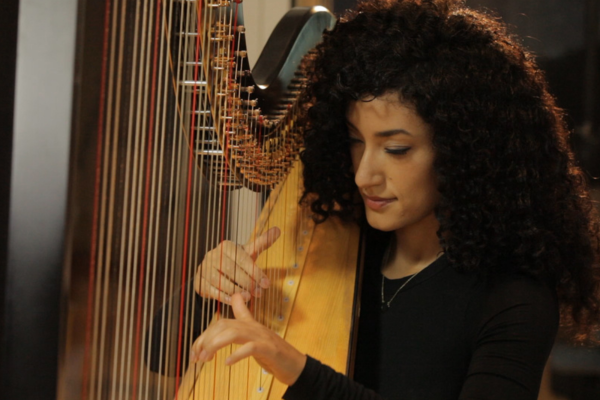
…working hard, building your technique, growing musically, and getting stronger is really all about understanding yourself. Sound is just a just a vehicle for that. It’s a way to express your artistic voice and ideas.
HC: You mentioned earlier that the modern music landscape has opened up opportunities for what you’re doing now. How would you say the music world is different today compared to when you were starting out?
ES: Well, when I was starting out, I remember being in grad school thinking, How am I going to make money? Of course, we all think about that, but when you’re in school, there’s this optimism that it’ll all work out somehow. The traditional orchestral path was always the most obvious route for harpists. I definitely dreamed of playing with great orchestras. But deep down, I knew I didn’t only want a principal harp position. If I were doing that every week, I’d be constantly responsible for performing these incredible classics—which, don’t get me wrong, are amazing—but I realized I also wanted more creative freedom in my day-to-day. I didn’t want my work to be only about playing from a pile of music that’s already been written and well-known. That’s interesting and meaningful, but it wasn’t the only thing. So again, I found myself asking, How am I going to work and make money?
I had actually done a cruise ship gig before grad school, which was my first real job. That was an incredible experience—I played three hours every night, with one day off every ten days. I got to travel all around the world on this amazing ship and visit incredible places. But I remember right before I left for that job, I went to The Enchanted Harp, a music store outside Seattle, where I’m from. I had never played pop music on the harp before. I had just graduated from CIM with all this classical repertoire—sonatas, Salzedo—but I didn’t have any pop songs. They told me, “No, what they want is Andrew Lloyd Webber, show tunes, jazz standards, the Great American Songbook.” And I was like, I don’t know how to play that, and I have a degree in harp performance. So I bought every Ray Pool and Sylvia Woods book I could find. I didn’t even have time to learn the music before getting on the ship in Singapore—I just had to learn it on the job. Honestly, that experience was the best education. That’s when I realized there was a whole other category of harpists—people out in the world making their own arrangements, figuring things out on the fly. Someone would make a request, and instead of saying, Sorry, I don’t have that, I’d say, Sure!, figure it out, and come back the next day. Now, with technology, I can just download it on my iPad and sight-read it, and people light up.
That cruise job taught me so much. But I knew I didn’t want to stay at sea forever. It was cool at the time, but I wanted to build a career on land—as we’d say on the ship. By the time I was graduating from grad school, I had done a few gigs here and there, but I remember my teacher, Elizabeth Hainen, gave me great advice. She said, You have your whole life to gig. And she was right. Grad school is really your last chance to focus on practicing inconvenient music—academic, difficult pieces just for the sake of your recital or artistic growth. Then, right at the end of my degree—literally the last day of my master’s—I got a call about the Rittenhouse Hotel gig I’m still doing now. A colleague had recommended me. I graduated on a Thursday and started the hotel job that Friday. Incredible timing. At the hotel, I was able to do what I’d done on the cruise—combine my classical training with a more flexible repertoire. They didn’t care what I played, which gave me room to explore. It was a steady paycheck, and I could still take orchestral freelance work. So to circle back to your original question—when I first started freelancing around 2013, there was a lot of freelance orchestral work, especially in the Philadelphia region. I still play with some of those orchestras, but it’s become much more limited—at least in my experience.
HC: What would you say is the best part of your job?
ES: Oh, definitely the people I get to meet. There’s this amazing feeling of connection—once you get to a certain level in music, you start realizing that everyone is just a cool, down-to-earth person who has worked really hard and genuinely loves music. And then, you keep meeting more of those kinds of people—people who are inspiring, who have stayed committed to this path—and getting to actually work with them is incredible. There’s also this deep satisfaction in being able to play the music I love—the music I listen to—for myself. And maybe that’s a little self-indulgent, but that’s often what resonates most with others, too. Shaping a repertoire that’s entirely my own has been one of the most rewarding parts. I genuinely enjoy playing it. It feels so easy and enjoyable.
HC: You’ve reached a point in your career, and like you said, you’re now working with others who have also stuck it out and survived in this field. What do you think has helped you be successful up to this point?
ES: Definitely tenacity. I know I have that in my soul—I’ve always had that deep within. I’ve always just loved the harp, loved music. I honestly couldn’t imagine my life without it. I think that alone is really important. If you’re doing this for any reason other than truly loving music, I don’t think this is the path for you. There are so many other careers that are far more financially responsible. [Laughs] But for me, it’s always been about that deep love for music.
Also, being a kind person, building strong relationships, and keeping a positive attitude have really helped. Even during the pandemic, which was so difficult—I had no work, my [steady] gig went away. And I didn’t even go on unemployment because I was so stubborn. I just pieced together a few gigs somehow. I don’t even know how I survived—it wasn’t healthy, and I don’t recommend it. But I wrote a lot during that time. I wrote my whole album then. I taught myself how to arrange music and really leaned into that creative side. And I think having at least a little entrepreneurial spirit is essential if you want to freelance successfully. There are weeks you might not get paid for work you’ve done, and then suddenly you’ll get a big check for everything. So being able to manage that inconsistency is key.
I’m only just now getting to a place where I feel more relaxed about it all. But it really comes down to keeping faith in yourself. I’ve tried to keep that faith, filling in the pieces as I go. It’s really rewarding to see those pieces coming together now. There’s the mindset that you’re only as good as your last gig—which I think is a negative mindset. For me, it’s more about always wanting to bring your best. You never know who you’re playing for. You never know who’s in the rehearsal room, who might recommend you, or who’s speaking highly of you somewhere else. So I try to lead with my own code—knowing what kind of colleague I want to be, what kind of musician I want to be, and how I can make other people’s lives easier. Especially when you’re hired for an event, you’re really a problem solver. They need entertainment, an atmosphere, a visual—it’s not just about the music. And on the business side, being super reliable and easy to work with is everything. There are so many skills involved.
HC: Yes, all of this is so true. I don’t think people talk about those soft skills enough. Everyone focuses on having the chops and the creative vision—but these other aspects are just as important, and we don’t really discuss them much.
ES: Totally. The soft skills—being grounded, knowing yourself—are so important. For me, freelancing is fun because every week it’s a different room, a different group of people, a different genre of music. I’ve tried to do the personal work to know who I am, as both a musician and a person, so I can show up authentically and be ready to work. Of course, once the mic is on or the curtain goes up—you just have to nail it. That’s the fun part for me now. At this point, the actual playing isn’t the hard part—it’s the logistics, like getting the harp into the building, that are tough. But performing itself? That’s where the joy is, and I really love it.
HC: Tell us a little about your regular gig at The Rittenhouse Hotel.
ES: I’ve been there since grad school—since 2013. They paused during the pandemic, as many places did, but I’ve been back and it’s going strong. Right now I play three and a half hours for afternoon tea Fridays, Saturdays, and Sundays. I have a harp I can keep there, which makes all the difference. The atmosphere is just amazing.
HC: What have you learned from playing that afternoon tea gig three days a week?
ES: Definitely, the biggest thing is to make your own arrangements—not just so you don’t get bored, but so you can really enjoy that time and create your own sound. People light up when they hear me play my favorite songs, and I’ll say, “That’s my favorite too!” That shared joy keeps me going. Some people see gigs like that as practice time, but I think of it more as performance time. It’s a great opportunity to expand your repertoire. Maybe I’m not doing enough video game music, or I could add more rock or soul. I’ll download whatever people request now. I used to be strict—like, “I’m going to play the Salzedo Suite of Eight Dances every day”—but now I might play three hours of pop, R&B, soul, and I love it. Having that kind of gig keeps me in playing shape. It keeps my hands and body ready, and also keeps me mentally relaxed because I’m always performing. So when I walk into another performance, it just feels natural—like, “Hey, I’m here. Let’s play.”
And from the business side, it’s been really educational, too. You start to think like a business. The hotel certainly does—they’re running a business, and you have to fit into that. That’s something they never teach in music school, but it’s helped me immensely. Fortunately, the tea room is very successful—it’s always sold out and hard to get a reservation. So it’s created this whole atmosphere that’s not just good for them, but for me, too.
HC: Tell us a little bit about your album.
ES: I wrote it during the pandemic—it’s all covers of my favorite R&B songs by artists like Sade, Solange, SZA, and Beyoncé. Some were longtime favorites I wanted to arrange; others, like one Brandee [Younger] requested, were new. The harp’s sound was soothing during that intense time in Philadelphia, especially amid the George Floyd protests and heavy atmosphere. The arranging I did was painstaking—I transcribed everything by ear, recreating full band textures on harp: vocals, bass, drums, keys. I decided to keep it fully acoustic, recorded like a classical album. We used 13 mics to capture that intimate, immersive harp sound with a modern pop sensibility.
HC: One thing freelancers have to do is walk into a situation and seamlessly integrate with people they may have never played with before—especially if that group has a history together. How have you learned to do that from the first rehearsal?
ES: That’s a great question. Early in my career, I did a lot of freelancing and orchestral subbing—with groups like the Baltimore Symphony and the Delaware Symphony. If you’ve done that kind of work, you know: when you’re subbing, the goal is almost to be invisible. You want to be totally prepared—note-perfect from the first rehearsal—so that people say, “Who was that? Oh, she sounded great,” and move on. Nothing remarkable, in a way, which was an attitude I struggled with. But those situations require total musical trustworthiness and flexibility.
So yes, you need to be musically solid and fully know your part. But now I’m often in spaces where there isn’t any sheet music—maybe just a chord chart, or even nothing at all. The band leader might yell, “Hey Elizabeth, can you play this chord here?” or “What if you try this progression?” That kind of environment requires flexibility and confidence to just jump in. Doing all that arranging [for my album] helped me develop that. I became comfortable figuring out chords and voicings that I liked, and even glissandos—I could write a whole book on pop glissandos. There’s a harp nerd section of my brain that’s always working. It’s about developing a little bag of tricks—if someone says they want something “ethereal” or “magical,” you know how to interpret that on harp. And then, artistically, you ask: What’s the sound palette? What’s the vibe? What’s going to add value and not muddy the texture?
I get really excited about showing people how good the harp can sound in a modern pop context. People are often blown away. If you approach it like a creative workshop—where everyone is experimenting and learning together—that’s really effective, especially with composers or musicians adjusting things on the fly. Harpists are notorious for needing everything written out—pedal markings, fingerings, exact music. But if you can throw some of that out the window and get creative, you can contribute something really unique. That’s what makes people say, “Let’s have her back” or “Call her again.” Also, there’s a practical advantage: if you can just jump in without needing someone to write out a full part or explain everything, that’s incredibly valuable. So for harpists looking to do more of that kind of work, I’d say—get comfortable playing over your favorite tracks, whatever genre you love. Ask yourself, What would I add to this? Get weird. Get creative. So when you’re in the studio, or at the Kimmel Center, or the Kennedy Center, wherever—you can offer something spontaneous that makes people say, “Yes, that!”
HC: You’ve played a lot of really cool gigs. Do any stand out as particularly memorable?
ES: Oh, absolutely. I think the Biggie show was definitely one of the most memorable. That was such a cool confluence of things. I had known Miguel Atwood-Ferguson’s work and really admired him as an arranger. So when I saw that he had written this three-minute extended harp solo, I was beyond excited. So walking into that room, I knew I had to nail it in the rehearsal. I thought, If you’re going to give a dog a bone, I’m going to take it. [Laughs] We just don’t get to do things like that very often—especially not harp solos in a hip-hop show at Lincoln Center! That was incredibly exciting.
I was also really grateful to play at the Kennedy Center Honors recently—that was another highlight. And then doing more live TV things, like The Tonight Show, that kind of energy is amazing. Knowing that the camera is on, the mic is on, it’s live—there’s no going back. All the time I’ve spent in the studio, arranging, practicing, even just recording myself on my phone to post on Instagram—that all becomes practice for moments like that. If I weren’t constantly in that kind of flow of playing, I think those situations would be a lot scarier.
HC: What would you say have been the most challenging aspects of your freelance career?
ES: Financially, you really have to be okay with uncertainty. There are definitely months that are challenging, but those times have really shown me who I am and what I’m made of. They’ve affirmed for me that I’m in this for the long haul. I love doing this. If I didn’t, I would’ve quit a long time ago and taken a nine-to-five or a corporate job. I’ve also had admin roles, and I honestly think people who can balance that with playing are brilliant. You’re creating a cushion for yourself, and if you don’t have some kind of steady thread, it’s really hard to stay creative. I mean, during the pandemic, I was creating and it was lovely, but that kind of creativity can only last maybe three months—it’s not sustainable. So, as cool and romantic as the creative lifestyle sounds, it’s not always realistic. There’s nothing wrong with building financial stability in whatever way works for you—whether that’s teaching, admin work, or even a day job while taking gigs on weekends. A lot of people do that, and it’s completely valid.
Before I started doing my own arranging, I didn’t feel like I had much of a musical identity. It was more like, “Who’s hiring a harpist for this gig?”—just filling a role. But now, it’s like, “We need to call Lizzie for this sound,” because I’ve created something specific and recognizable. That shift has given me so much more confidence. That kind of clarity comes with age and experience—playing more music and getting to know yourself better. Earlier in my career, I felt like I had to prove myself constantly. I knew I was good, but I needed the platform, the opportunity. Now it’s less about ego and more about alignment. I’ve created a path that feels right for me. If I were only playing one genre, like strictly classical, I think it would feel a lot more limiting. But having that classical foundation is what allows me to perform pop and other genres at the level I want. I really stand by that.
HC: That’s a great point. So, looking back a little bit, can you tell us your story—how you came to the harp and how you started playing?
ES: I’m from Seattle and started on piano, which I loved. At Washington Middle School—known for its strong music program—I wanted to join orchestra or band, so I asked what instruments they needed. The teacher said, “We have a harp,” and I was instantly intrigued. I’d never even seen one in person, but I was hooked. A volunteer, Carol Levin, offered to teach me, and I started the next day. My school had harps, so I played daily from sixth through eighth grade, then continued in high school. My parents rented a harp until they eventually bought one.
My piano teacher recommended I study with Heidi Lehwalder. She wasn’t taking students, but my parents convinced her. Heidi introduced me to the professional music world and shared inspiring recordings that really motivated me.
HC: That’s amazing—I didn’t realize you studied with her.
ES: I studied with Heidi in middle school, then with Susi Hussong and Alison Austin in high school. I played in Seattle Youth Symphony and my high school orchestra—we did some major works. I even played Tzigane in high school after finding out they planned to hire a pro. I didn’t know what I was doing, but I learned it. That experience made me want to go to conservatory.
At 15, I did a masterclass with Judy Loman, who told me I had musicality but no technique. I had tendonitis from overplaying, so I refocused with Alison on technical fundamentals. Eventually, I auditioned at Cleveland and Oberlin because I wanted to study with Yolanda Kondonassis. After a trial lesson, I knew she was the right teacher. I got into CIM and dove into serious practice. Conservatory gave me the structure and technical tools I needed, though back then the focus was very orchestra-job oriented. Yolanda encouraged some creativity—we even had a transcription class that planted the seed for my later work adapting pieces to harp.
After CIM, I moved home—burnt out and unsure if I wanted to stay in music. I practiced, worked catering jobs, and took lessons with Heidi. Then, on the last day of spring break, I got a cruise gig.
HC: It feels like a lot of things happen for you on the last day of something.
ES: [laughs] It’s true! Big moments have often felt like signs pointing me forward. After the cruise, I moved to Philadelphia for my master’s with Elizabeth Hainen. I’d studied with her at Saratoga Harp Colony, which was transformative. Studying with her helped me reconnect with sound and artistry. I played dramatic rep like Ballade, which I now realize includes a lot of jazz language. I wish I had learned it with that context in mind—it shows how much classical rep is rooted in Black American music and jazz.
While finishing my degree, I started working with the Lyra Society, Elizabeth’s nonprofit. That felt full-circle for me: I got my start because someone volunteered at my school, and Lyra gives that same opportunity to kids today. Teaching in the same Philly school that Ann Hobson Pilot attended made it even more meaningful.
HC: Who would you say have been your biggest musical influences? Maybe some of your teachers, or perhaps artists you’ve listened to or worked with?
ES: That’s such a hard question, but honestly, my parents were huge influences. They played a lot of music in the house. I always talk about how they had radio shows in the ’70s and ’80s—they just loved music. Neither of them were professional musicians, but they both played a little and passed on this deep love for all kinds of music. That love for different genres has really stayed with me.
I remember listening to Ravel and Fauré through my mom before I even played the harp. And we also listened to a lot of Ryuichi Sakamoto, who’s a major influence on me. I absolutely love his work. He transcended genre—he did film scores, pop music, experimental work. He really did everything, and he was hard to categorize. I admired that so much. Of course, I’ve been influenced by everyone from Bach to Duke Ellington. Sade is also a huge influence—her sound played a big part in shaping my album. Honestly, there are too many to name, and the list is always growing.
And then of course, my teachers have been essential. They helped me develop the technical ability to express the sounds I love. I think one of the greatest things as a musician is finally reaching the point where you can hear a sound in your head and actually play it. That’s a long journey.
There’s a quote from Miles Davis that I always think about: “It takes a long time to sound like yourself.” It’s so true. Even when I was younger, I knew the kinds of sounds I loved—like ’90s R&B, or the video game music I heard when we visited Japan when I was four. I was so drawn to the sounds I heard there; they completely blew my mind. And now, I can finally understand what they were doing harmonically, which is really exciting.
HC: If you could give one piece of advice to young harpists who want to become professionals, what would it be?
ES: I would say: know your why. Know what it is you love about music and the harp, because the path isn’t always glamorous. A lot of it is tedious, lonely, and incredibly stressful—physically and mentally. You have to remember that working hard, building your technique, growing musically, and getting stronger is really all about understanding yourself. Sound is just the vehicle for that. It’s a way to express your artistic voice and ideas.
So try to make choices—whether it’s gigs, teachers, opportunities, even relationships—that let you be your full, authentic self. Don’t just aim to fit into the typical “harpist” mold, because that idea is outdated. Even the harpists we now consider “old school” were trailblazers. Dorothy Ashby, Eleanor Fell—they made their own way, created their own sound, and followed what they loved. And when you do that—when you really play what you love—it comes back to you. •





